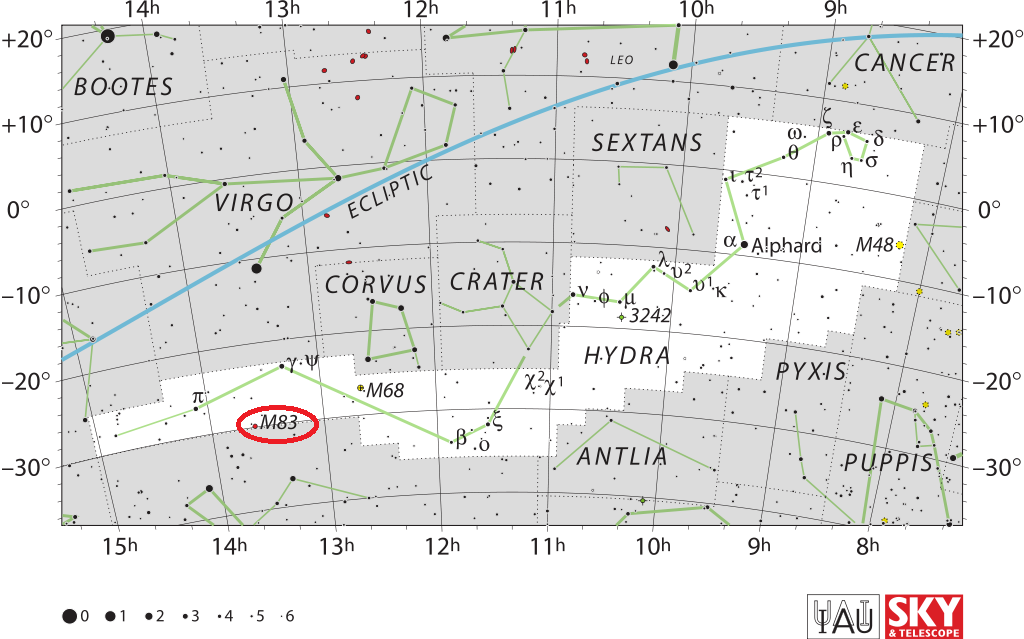Messier 83 (M83), also known as the Southern Pinwheel Galaxy, is a barred spiral galaxy located in the southern constellation Hydra. M83 lies at a distance of 15.21 million light years from Earth and has an apparent magnitude of 7.54. It has the designation NGC 5236 in the New General Catalogue.
The Southern Pinwheel Galaxy occupies an area of 12.9 by 11.5 arc minutes of apparent sky, which corresponds to a spatial diameter of about 55,000 light years, or roughly half the size of the Milky Way. M83 is one of the nearest and brightest barred spirals in the sky and can be seen in 10×50 binoculars, which only reveal a patch of light with a brighter core.
3-inch telescopes show a larger patch of nebulosity with a bright centre, while 6-inch telescopes begin to hint at the bar structure and the dark patches around the galaxy’s central region. 10-inch telescopes reveal the galaxy’s well defined spiral structure, dark dust lanes and the central bar.
Located 30 degrees south of the celestial equator, Messier 83 is the southernmost galaxy listed in Messier’s catalogue, which makes it one of the most difficult Messier objects for northern observers because it never rises very high above the southern horizon.
The galaxy lies near the border with Centaurus constellation, about three quarters of the way from the bright star Spica (mag. +1.04) in Virgo to Menkent (mag. +2.06) in Centaurus. It can also be found using the stars Gamma or Pi Hydrae. The galaxy is located 6.5 degrees south and 3.15 degrees east of Gamma (mag. +2.99) and 3.15 degrees south and 6.20 degrees west of Pi Hydrae (mag. 3.25). The best time of year to observe M83 is during the spring.
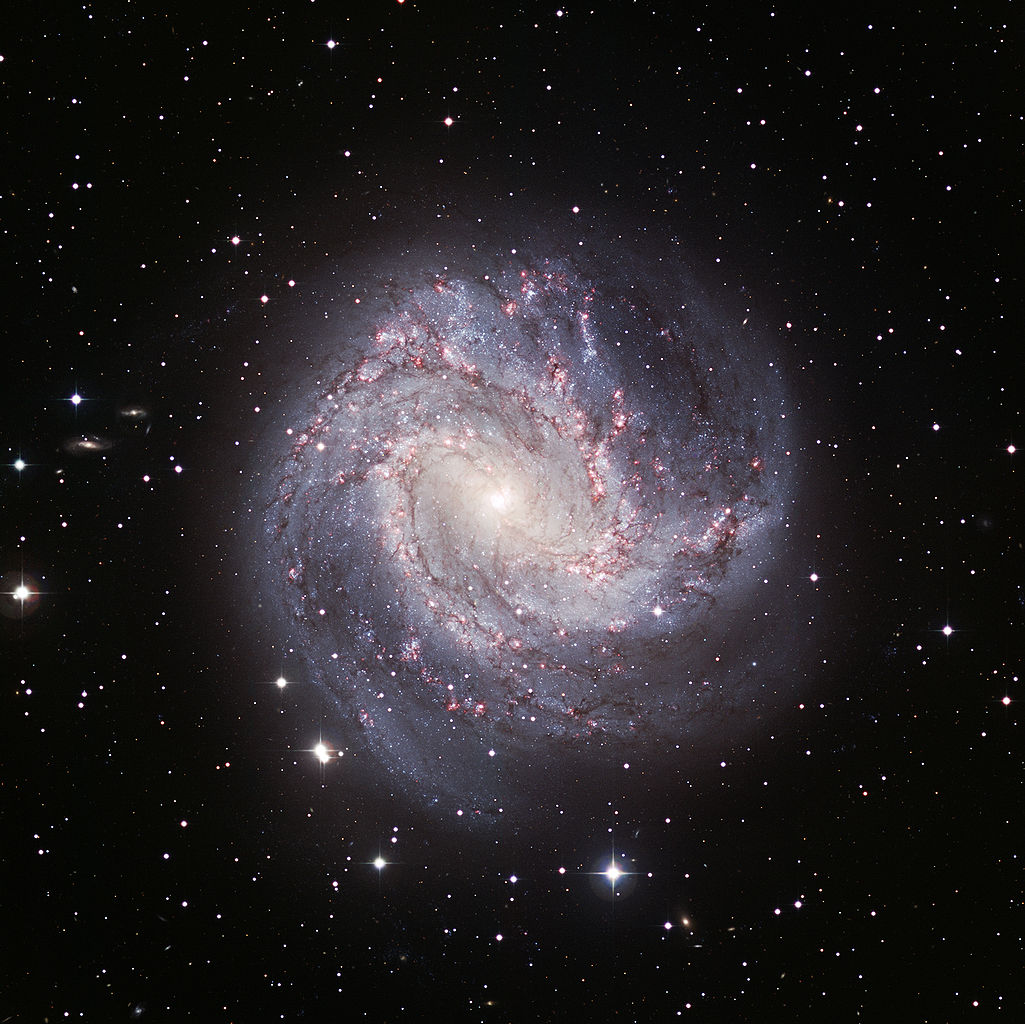
Messier 83 was the first galaxy to be discovered outside the Local Group and the third of all galaxies, after the Andromeda Galaxy (M31) and Le Gentil (M32), both located in the constellation Andromeda.
The Southern Pinwheel Galaxy has a well-defined spiral structure and is classified as an intermediate spiral, between normal and barred spiral. The galaxy is receding from us at 337 km/s.
Messier 83 is the central galaxy of the M83 Group, one of the two subgroups of the larger Centaurus A/M83 Group, which also includes Centaurus A and the irregular galaxy NGC 5253. The largest member of the other group is Centaurus A, a prominent starburst galaxy located in the constellation Centaurus. The two groups are physically close and do not appear to be moving relative to each other, which is why they are often identified as a single group.
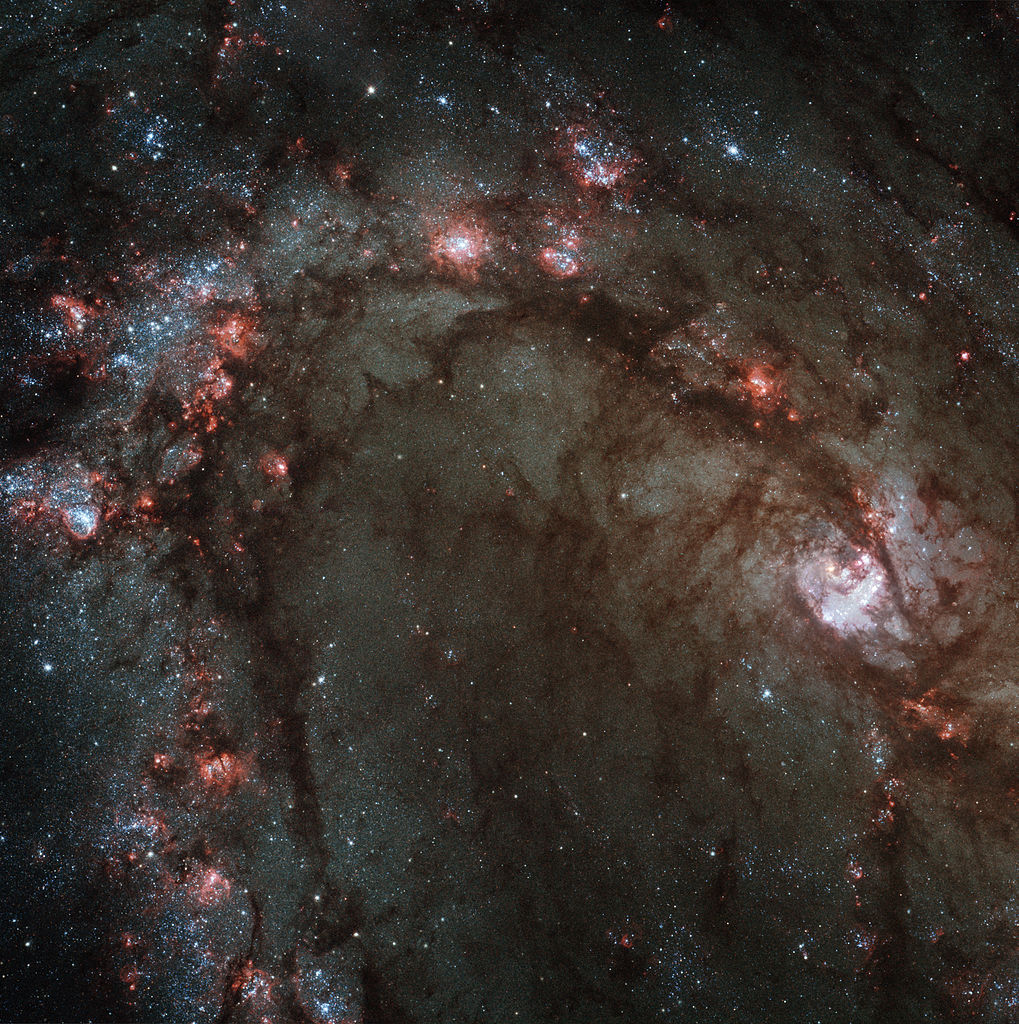
The image reveals in unprecedented detail the current rapid rate of star birth in this famous “grand design” spiral galaxy. The newest generations of stars are forming largely in clusters on the edges of the dark dust lanes, the backbone of the spiral arms. These fledgling stars, only a few million years old, are bursting out of their dusty cocoons and producing bubbles of reddish glowing hydrogen gas. The excavated regions give a colorful “Swiss cheese” appearance to the spiral arm. Gradually, the young stars’ fierce winds (streams of charged particles) blow away the gas, revealing bright blue star clusters. These stars are about 1 million to 10 million years old. The older populations of stars are not as blue. A bar of stars, gas, and dust slicing across the core of the galaxy may be instigating most of the star birth in the galaxy’s core. The bar funnels material to the galaxy’s center, where the most active star formation is taking place. The brightest star clusters reside along an arc near the core.
The remains of about 60 supernova blasts, the deaths of massive stars, can be seen in the image, five times more than known previously in this region. WFC3 identified the remnants of exploded stars. By studying these remnants, astronomers can better understand the nature of the progenitor stars, which are responsible for the creation and dispersal of most of the galaxy’s heavy elements. Image: NASA, ESA, and the Hubble Heritage Team (STScI/AURA)
Until recently, the outer regions of M83 were believed to lack star forming material. However, on June 16, 2008, NASA’s Galaxy Evolution Explorer detected large numbers of very young, newly formed stars in these regions.
Observations with the Hubble Space Telescope have revealed that the galaxy’s core has a double nucleus, a feature it shares with the Andromeda Galaxy (M31). This does not mean that M83 has two supermassive black holes at its centre, but possibly that the central black hole may be surrounded by an orbiting disk of stars which gives the appearance of a dual core. Neither of the two nuclei is aligned with the kinematic centre of M83. The visible nucleus is offset from the kinematic centre by about 200 light years.
The double nucleus of M83 may be explained by a merger with a smaller galaxy that occurred in the distant past. The second nucleus may be the remnant core of the other galaxy that was absorbed by the larger M83.
The central 1,000 light years of M83 also has a double circumnuclear starburst ring.
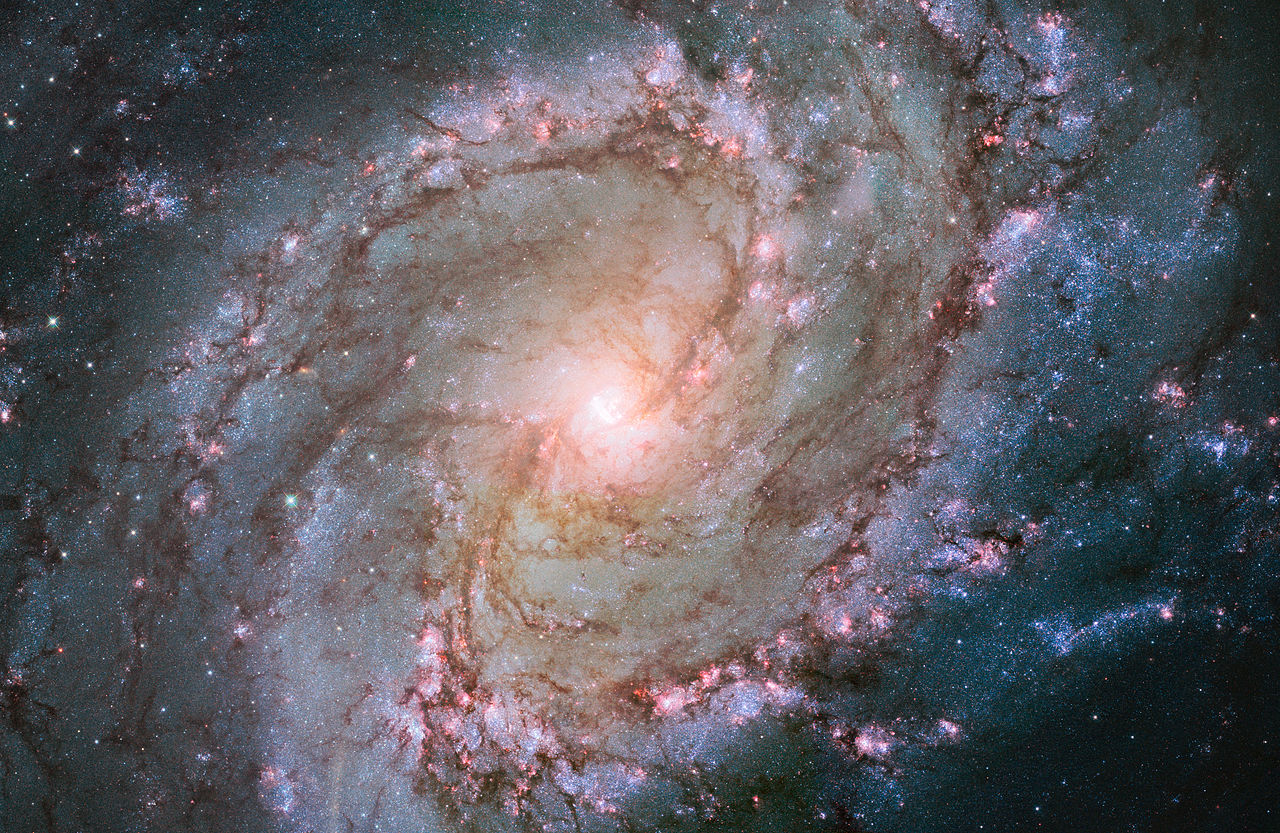
The central bar of the Southern Pinwheel Galaxy extends for more than a third of the galaxy’s length. It may be responsible for most of the star forming activity in the core of M83 as it funnels material to the central region.
The Southern Pinwheel Galaxy is home to about 3,000 star clusters, some of which are less than 5 million years old.
Six supernovae have been detected in M83 in the last century: SN 1923A in 1923, SN 1945B in 1945, SN 1950B in 1950, SN 1957D in 1957, SN 1968L in 1968 and SN 1983N in 1983.
SN 1923A, a Type II supernova, was detected at magnitude 14 at Lowell Observatory in 1923. SN 1945B appeared on July 13, 1945, but was only discovered on photographic plates in 1990. It peaked at magnitude 14.2.
SN 1950B peaked at magnitude 14.5 in 1950 and SN 1957D, detected about 3 arc minutes from the nucleus of M83 on December 13, 1957, reached magnitude 15.0. Both were classified as Type II supernovae.
SN 1968L was a Type I supernova seen about 5 arc seconds from the nucleus. At its peak, the supernova had a visual magnitude of 11 to 12. SN 1983N was spotted on July 3, 1983 and peaked at magnitude 12.5.
In addition to the supernova events, almost 300 supernova remnants have been detected in the galaxy.
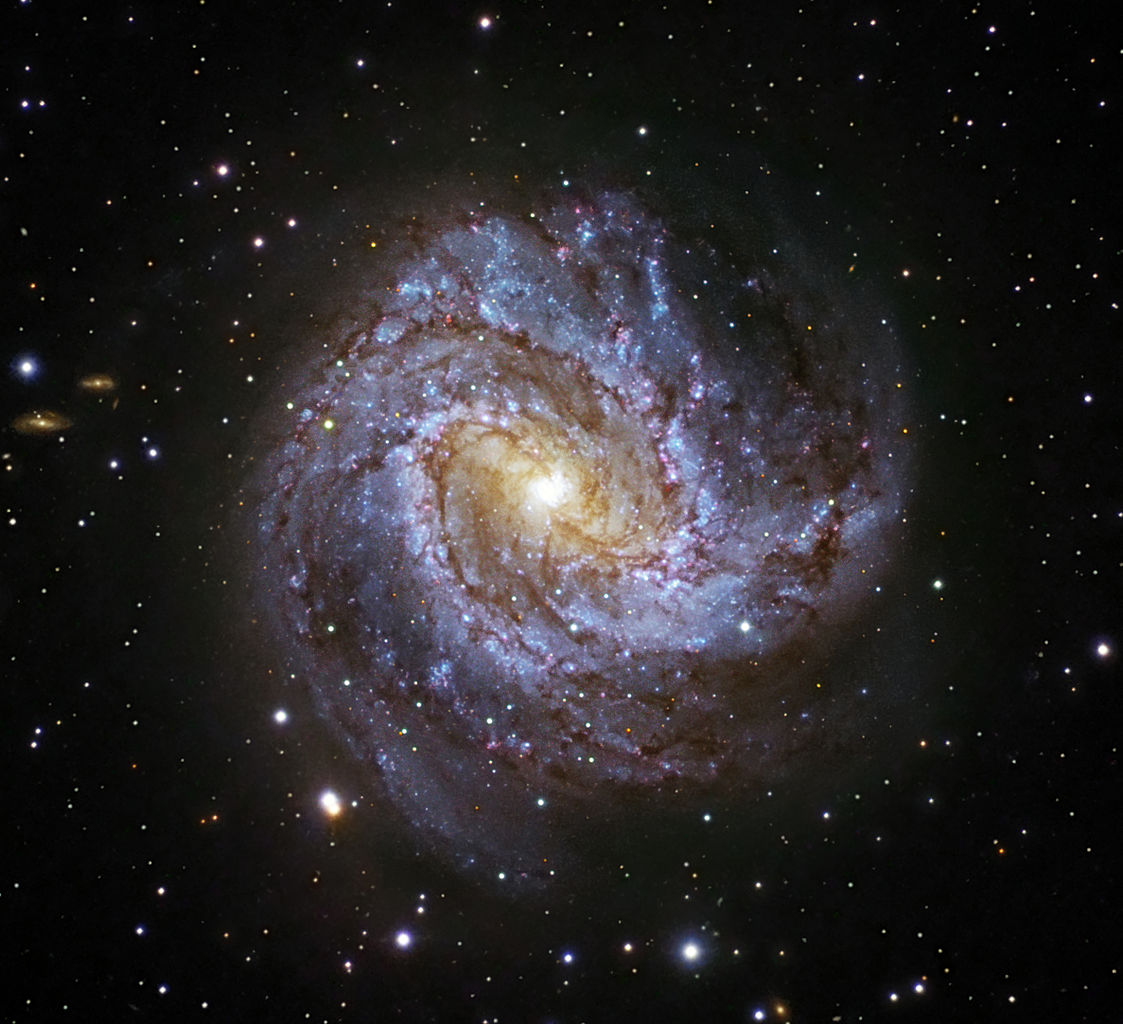
The Southern Pinwheel Galaxy was discovered by the French astronomer Nicolas Louis de Lacaille on February 23, 1752 at the Cape of Good Hope in South Africa. Lacaille catalogued the object as Lacaille I.6. and described it as a “small nebula, shapeless.”
Charles Messier included the object in his catalogue on February 17, 1781. He wrote:
Nebula without star, near the head of Centaurus: it appears as a faint & even glow, but it is difficult to see in the telescope, as the least light to illuminate the micrometer wires makes it disappear. One is only able with the greatest concentration to see it at all: it forms a triangle with two stars estimated of sixth & seventh magnitude: [its position was] determined from the stars i, k and h in the head of Centaurus: M. de la Caille has already determined this nebula. See the end of this Catalog.
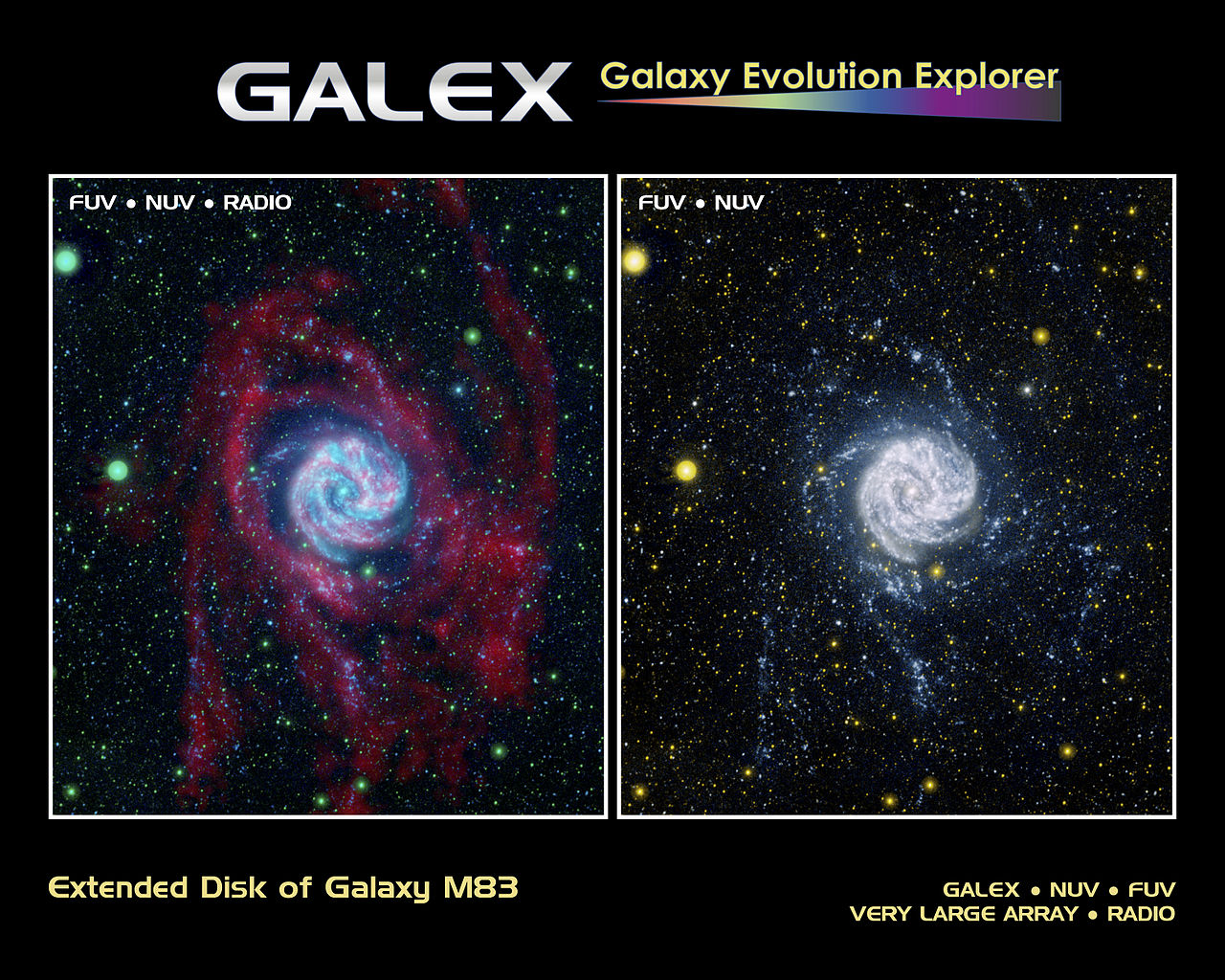
In the Galaxy Evolution Explorer image on the right, near-ultraviolet light (or longer-wavelength ultraviolet light) is colored yellow and far-ultraviolet light is blue. In the combined image at the left, far-ultraviolet light is blue, near-ultraviolet light is green, and the radio emission at a wavelength of 21 centimeters is red. Image: NASA/JPL-Caltech/VLA/MPIA
English astronomer William Lassell noted the object’s spiral structure and sketched it, describing it as a “three-branched spiral.”
Scottish astronomer James Dunlop added M83 to his catalogue as number 628 in 1827. After observing the object from Australia, he wrote:
185 Centauri (Bode) is a very beautiful round nebula, with an exceedingly bright well-defined planetary disk or nucleus, about 7″ or 8″ diameter, surrounded by a luminous atmosphere or chevelure, about 6′ diameter. The nebulous matter is rather a little brighter towards the edge of the planetary disk, but very slightly so. I can see several extremely minute points or stars in the chevelure, but I do not consider them as indications of its being resolvable, although I have no doubt it is composed of stars. 5 Observations.
John Herschel catalogued M83 as h 3523 and later added it to the General Catalogue as GC 3606.
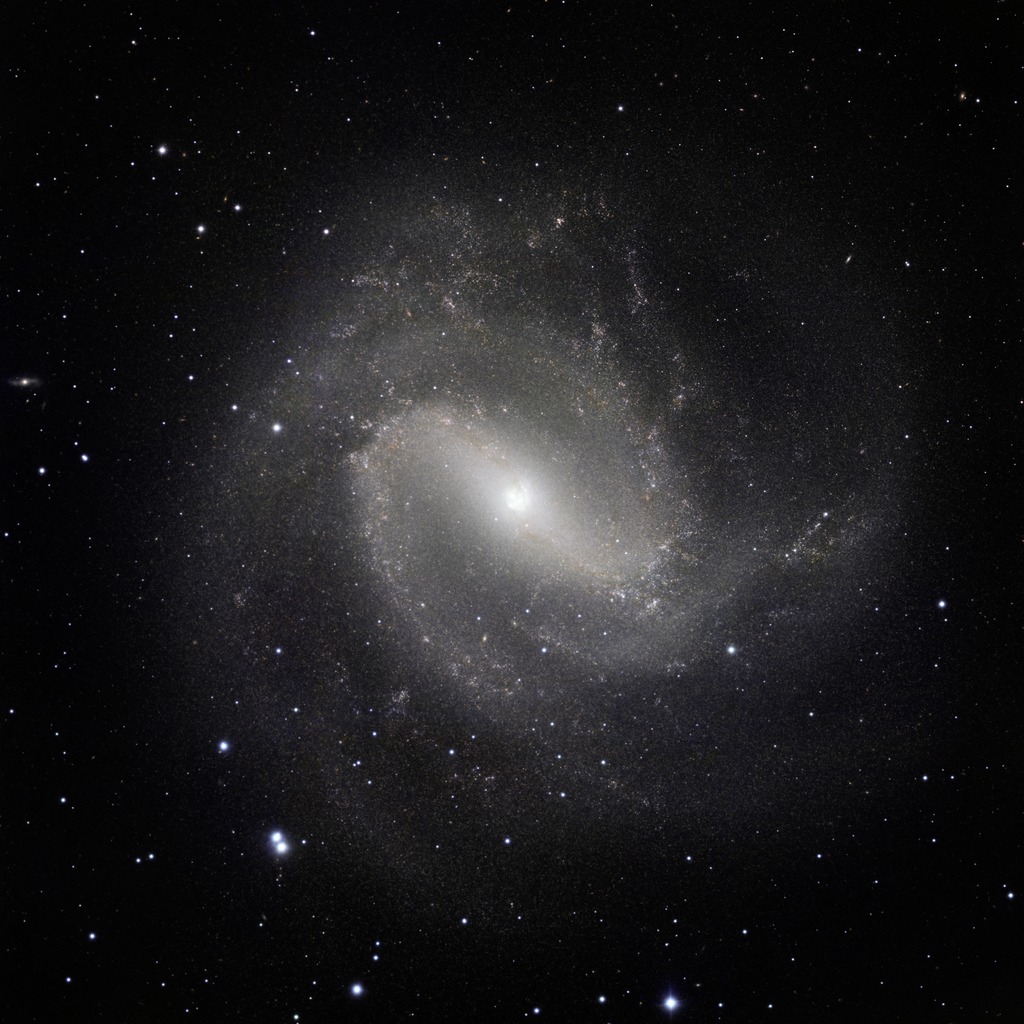
FACTS
| Object: Galaxy |
| Type: Barred spiral |
| Class: SAB(s)c |
| Designations: Messier 83, M83, NGC 5236, Southern Pinwheel Galaxy, PGC 48082, UGCA 366, 2E 3112, 2E 1334.2-2936, ESO 444-81, IRAS 13341-2936, 2MASX J13370091-2951567, MCG-05-32-050, MRC 1334-296, MSH 13-2-05, PKS 1334-296, RBS 1293, RX J1337.0-2952, SPB 225 |
| Constellation: Hydra |
| Right ascension: 13h 37m 00.9s |
| Declination: -29°51’57” |
| Distance: 15.21 million light years (4.61 megaparsecs) |
| Number of stars: 40 billion |
| Apparent magnitude: +7.54 |
| Apparent dimensions: 12′.9 x 11′.5 |
| Radius: 27,500 light years |
| Redshift: 513 km/s |
LOCATION
